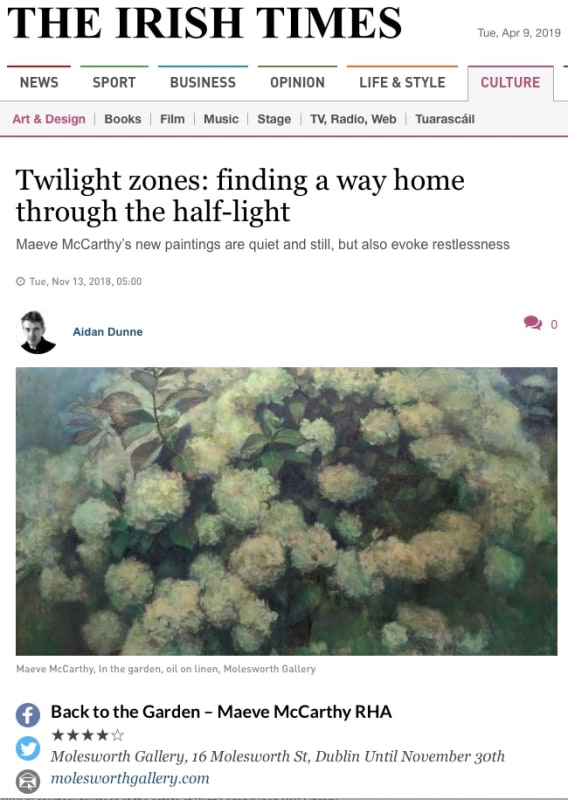Maeve McCarthy’s paintings in Back to the Garden are not entirely given over to the garden, though it features large, in a haunted, misty, mysterious way: masses of lush hydrangea blossoms looming out of the damp foggy night, trees against the sky, massed borders of perennials in shade. The first painting in the exhibition is called Abandoned Village, a cluster of low buildings in the distance, again by night – night and twilight are the abiding times throughout all of the work. It’s interesting that the largest pieces in the show, by far, are the close-up, compressed views of blossom in the containment of the garden, while more expansive views, even those evoking immense spaces, are small in scale.
The effect is akin to long shot and close-up, cinematically (McCarthy worked in film animation for a while, and she has made at least one video closely related to her painting), with the close-ups drawing us, even compelling us, into inner, psychological spaces.
The accompanying gallery note puts the work in context, sketching a background story that is something like this: McCarthy is saying goodbye to Brandon, Co Kerry, where she lived for a time. Perhaps it is the abandoned village mentioned. Both her parents died during this period. She returned for a while to her family home, in Glenageary, Co Dublin – a common enough experience, and one with all the strangeness of revisiting a familiar world that has lost its familiar people.
She will be moving on from Glenageary in the not-too-distant future. All of this experience, reflection and anticipation is distilled in the paintings, which are very quiet and still. They express both a state of being detached, at one remove, even a restlessness, but also a profound emotional resonance, and perhaps a desire for home and belonging; varieties of prospect and refuge, in a way.
The houses we see, handsome terrace dwellings, illuminated in the darkness by the glow of electric light, are inviting, but they also appear vacant, undercutting their welcome, and perfectly embodying the ambivalent, paradoxical inclination to maybe settle – or just to move on.
Pictorially, McCarthy’s viewpoint, and hence ours, is that of an outside observer. Well known as a portrait painter, here she opts not to depict people, but her paintings are clearly about people, about life, and we can easily relate to them via our own experiences. A technically accomplished artist, she favours technique that does not advertise itself, and in this body of work it certainly doesn’t. She sets herself many challenges and more than meets them, all without being showy. But take a moment to consider how well these paintings are made and you will appreciate the exceptional level of her achievement.

